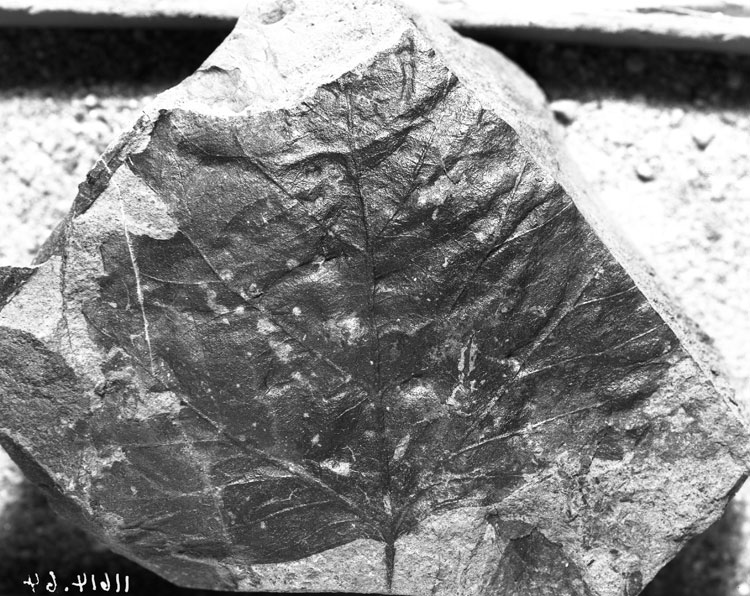Locality
USGS11614
60.610° -164.825
Baird Inlet (C-8) Quad. Nelson Island.
Matrix is a poorly bedded yellow-gray micaceous siltstone.
Description
Leaf: simple; asymmetrical; very wide ovate (?); apex missing, base very shallowly lobate with a decurrent petiole insertion, petiole normal, margin unknown (probably toothed) except at the base where it is entire; venation basal, marginal (?), imperfect (?), actinodromous; primary midvein moderate, straight; pectinal veins arising at an angle of 55° on one side and 40° on the other, straight or shallowly curved; abmedials arising at angles of 30-40°, moderate, more or less straight, probably branched near the margin; superior secondary veins arising from the primary midvein at an angle of 50-55° on one side and 40-45° on the other, branched abmedially near margin; tertiary veins percurrent convex; two pairs of veins of third order arising abmedially from the base of the pectinals, recurving into the very shallow basal lobes, the more basal pair of these veins weaker than the other pair, possibly a pair of still weaker inferior secondary veins arise from the midvein.
Remarks
This leaf is almost identical to Hollick's (1930, p. 65; Plate 34, Fig. 5) specimen Populites platanoides from his Lower Yukon River localities. Hollick noted the similarity to 'Platanus'? wardii (Knowlton, 1900, p. 14; Plate 2, Figs. 1-4) and seems to have erected his species name solely on the grounds of larger leaf size (up to 18 cm wide compared to 4-11 cm for Knowlton's specimens) which, bearing in mind the variability within these leaf forms, is insufficient basis for erecting taxa. Knowlton's specimens, like those of Hollick and that figured here, lack an apex and details of the margin are poorly preserved. They were collected by Lester F. Ward in 1883 from a locality stratigraphically placed between the Niobrara Formation and the Pierre Shale (see notes by Stanton in Knowlton, 1900, p. 10-11) and indentified by Knowlton (1919) as being part of the Eagle Sandstone which make them probably of Campanian age. This same locality also yielded specimens of Thinnfeldia montana = Protophyllocladus polymorpha (form GU67).
It is also worth comparing this specimen with that figured by Bell (1949; Plate 11, Fig. 3 only) under the name 'Vitis' stantoni Knowlton from the Edmonton Formation of Alberta (Maastrichtian to Danian). There are slight differences between Bell's specimen and that figured here but the differences (for example, angle of pectinals and secondaries) are not great.
The closest similarity, however, is seen in 'Platanus' primaeva, particularly in that specimen figured in Takhtajan (1974; Plate 74, Fig. 1) which is considered to be Cenomanian to Turonian in age.
